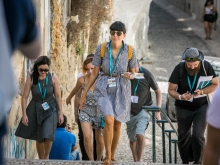Szombathely
Main economic activities in the city are commerce, automotive services, industry (multinational manufacturing companies in IT, electronics and automotive sectors are located here), while real estate sector, tourism, wood industry and food processing have also a significant share in employment and economic output, too. The city is located at the North-south road and railway corridors connecting Central Europe and the Mediterranean area, logistic services linked to freight transport are therefore substantial part of the local economy.
The following indicators should be considered with regard to urban challenges in the city:
• The proportion of people aged 25-34 years is higher than the national average.
• The gross added value per capita is below the national average, but is still one of the
highest in Hungarian cities of similar size.
• The city has very low unemployment rates in the past years; companies located here
are often challenged by the shortage of labour in certain industrial branches and
professions. The unemployment rate is 3,6 %.
• Szombathely’s society has a rather homogenous ethnic structure: around 98 % of the
population is Hungarian according to 2011 census. 2 % are Germans, Croatians, Gipsies
and Slovenes. Parallelly, 5,5 % of the total population declared to have double mother
tongues: German, Croatian, Gipsy and Slovene.
• The city has no coherent areas struck by social deprivation or characterized by
segregation of disadvantaged groups.
• 48% % of the city’s population had attained up to a 2nd level qualification while 23,6%
had attained a 3rd level qualification or higher.
• A stable and substantial inward migration is experienced in the city.
Szombathely describes itself as the “City of culture”, referring to the 2000 years of continuous history of the city, including Roman times. Szombathely is also often called “The city of Saint Martin”, the most famous Central-European saint that was born 1700 years ago in Szombathely, and his cult is continuous ever since.
A former image of the city it was “The Queen of the West”, referring to the central location and function of the city in West-Hungary before 1920. Unfortunately the loss of Burgenland (previously a part of Hungary) caused that the city severely lost its importance. The enhancement of this historical period, also through the enhancement of the project area proposed (Hussar barracks) will hopefully helpful to give to the city a chance to increase its value to the “City of culture”.
SOME RELATED NETWORKS
MAPS
News
'Cities in Action-Stories of Change’ publication just released!
Article




